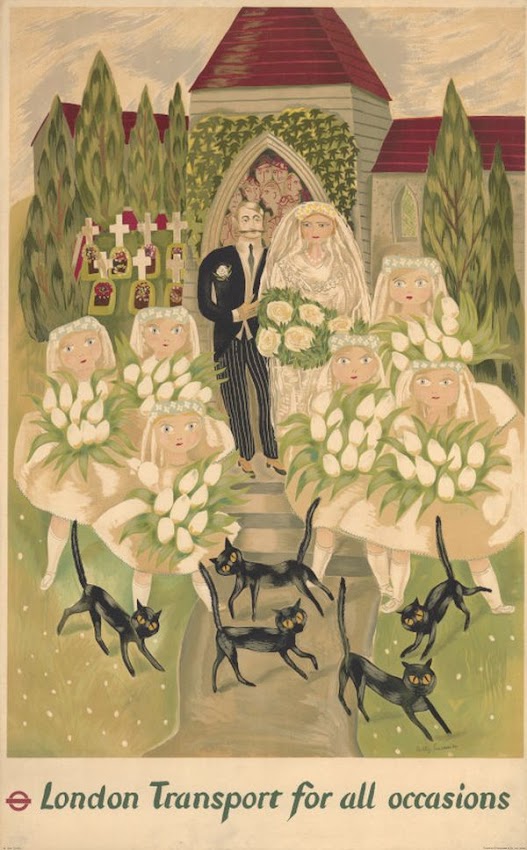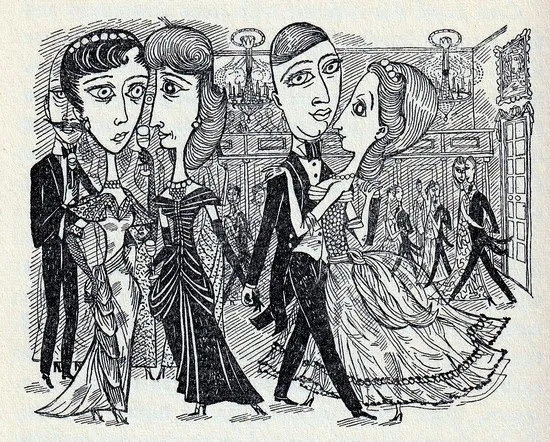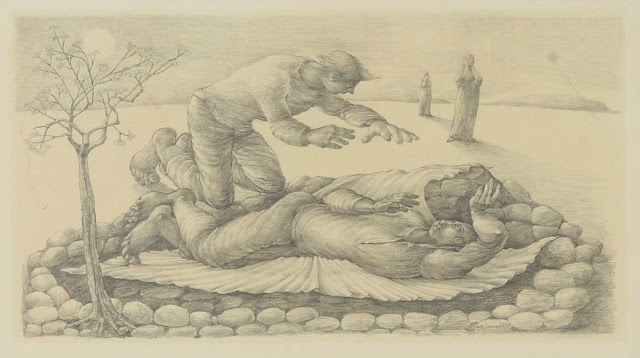 |
| Betty Swanwick c1948 |
Very early in her career, Betty Swanwick established herself as an illustrator and designer of great wit and invention, so complementing her friend and teacher, Edward Bawden. Later, she produced an extraordinary series of visionary watercolours and drawings in the tradition of William Blake and Samuel Palmer, which led to her election as a Draughtsman Member of the Royal Academy. She was born on 22 May 1915, the elder daughter of Harry Swanwick, who developed as a marine watercolourist while serving as a Paymaster in the Royal Naval Reserves. She was baptised at St Peter’s Church, Aldborough Hatch, near Ilford, Essex. Swanwick was educated at a local LCC elementary school, and later at the Prendergast Grammar School, Lewisham, South London. She received her first lessons in art from her father, and was encouraged by her art mistress at the Prendergast. Her father died when she was ten years old, a loss that threw her upon her own determination to develop as an artist. During her formative years and into early adulthood, Swanwick would continue to live in South London, first at Forest Hill and then at Sydenham. At the age of fifteen, she entered Goldsmiths’ College School of Art, where she was encouraged by Clive Gardiner, the Headmaster, and Edward Bawden, her tutor. Four years later, she received scholarships to both the Central School of Arts and the Royal College of Art, and attended them at the same time as Goldsmiths.
Swanwick received commissions even before such friends and contemporaries as Carel Weight and Denton Welch. As a result of seeing her work at a student exhibition at Goldsmiths in 1936, Frank Pick commissioned her to design her first posters for London Transport, and other projects soon followed. In the same year, she returned on a part-time basis, to teach Illustration at Goldsmiths, as a successor to Bawden. Highly talented – and highly respected by her students – she taught at Goldsmiths through the Second World War, and became a full-time Senior Assistant in the Illustration School in 1948. During this post-war period, she developed her range as an artist, painting watercolours and murals, providing illustrations for books and periodicals, and designing further posters.
Having begun to illustrate books from 1939, Swanwick produced her own texts, for both children and adults, from 1945. Describing her idiosyncratic social comedies for adults as ‘novelettes’, she populated them with large-headed wide-eyed figures with tiny feet. Though they hardly hinted at her later, more spiritual preoccupations, the images amply demonstrated her instinctive wit, her innate sense of design and her skilful draughtsmanship. As a whole, the publication of these books marked an important step towards the recognition of her originality, John Betjeman calling Hoodwinked (1957), ‘strange, startling, funny with a weird beauty’. In 1950, a rare solo exhibition at The Little Gallery provided a showcase for Swanwick’s anthropomorphic watercolours, which combined her love of animals and sense of fun in the most delightful way. Her mural designs, for venues such as the Festival of Britain (1951) and the Evelina Children’s Hospital (1955), were equally successful manifestations of her jaunty early style.
Soon after the retirement of Clive Gardiner from Goldsmiths in 1958, Swanwick became aware that the new Principal, Patrick Millard, was introducing changes in methodology that favoured the avant-garde. Most damaging for Swanwick was that drawing in general, and illustration in particular, was marginalised. Increasingly ostracised by those who represented the new order, she would seek solace in artistic certainties, and so carried with her a facsimile of one of Samuel Palmer’s sketchbooks. She eventually resigned as Senior Lecturer in 1970, and left her home in Greenwich for Downgate, Tidebrook, Sussex. By this time, Swanwick was working increasingly on large-scale figurative watercolours and drawings, and exhibiting them regularly at the Royal Academy Summer Exhibition. Gradually receiving some recognition, she was elected an Associate of the Royal Academy in 1972, and a Royal Academician seven years later. She was also elected a member of the Royal Society of Painters in Water-Colours in 1976.
In the poetry and intensity of the late narrative pictures, there is a level of achievement that suggests that Swanwick had overcome earlier anxieties. Yet there was something in her character that stopped her being as well known as she might have been. She preferred to spend her time working – and, as a perfectionist, completing work with difficulty – at home, and in the company of her dogs, her cats and Jobo, her African Grey parrot.
On returning to Greenwich in 1973, Swanwick taught again at Goldsmiths for one day a week and continued to do so for five years, by which time she had settled in Tunbridge Wells, Kent.
Swanwick died in hospital, in Tunbridge Wells, on her birthday, 22 May 1989. She left her money to four charities: the Celia Hammond Animal Trust, Friends of the Earth, Greenpeace and the World Wildlife Fund.
Footnote: My wife (illustrator Pauline Ellison) and I live in Tunbridge Wells. We knew Betty well and enjoyed afternoon teas at her cottage in the “Village” area, accompanied by her talkative (rude) parrot. She was a lovely lady; when she gave up working at the easel she gave her three-legged “easel stool” to Pauline:
This is part 1 of a 2-parts on the works of Betty Swanwick:
 |
| 1936 To the fields colour lithograph poster for London Transport 101.6 x 63.5 cm |
 |
| 1936 By Green Line colour lithograph poster for London Transport 101.6 x 63.5 cm |
 |
| 1936 To the farms colour lithograph poster for London Transport 101.6 x 63.5 cm. |
 |
| 1936 Smithfield Club Cattle Show colour lithograph poster for London Transport |
 |
| 1936 Fly away in Sussex colour lithograph poster for London Transport 101.6 x 63.5 cm |
 |
| 1937 Life Study pencil on paper 25.5 x 47.2 cm |
 |
| 1937 Kew Gardens colour lithograph poster for London Transport 102 x 64 cm |
 |
| 1937 Kew Gardens colour lithograph poster for London Transport 102 x 64 cm |
 |
| 1937 Chestnut Time Bushy Park by Underground colour lithograph poster for London Transport |
 |
| 1938 London Transport for all occasions colour lithograph poster 102 x 64 cm |
 |
| 1945 Cover of The Cross Purposes by Betty Swanwick "The Garden Party" published by Editions Poetry, London |
 |
| The Cross Purposes The Brother and Sister. |
 |
| The Cross Purposes The Ceremony |
 |
| 1949 Enjoy Your London Underground No.4 The River |
 |
| 1949 Poster for London Transport colour lithograph 13 x 62 cm |
 |
| 1949 Poster for London Transport detail |
 |
| 1949 Poster for London Transport detail |
 |
| 1949 Poster for London Transport colour lithograph 17 x 62 cm |
 |
| 1949 Poster for London Transport detail |
 |
| 1949 Poster for London Transport detail |
 |
| 1954 Wild or Savage colour lithograph poster for London Zoo 102 x 64 cm |
 |
| Hoodwinked: Written and Illustrated by Betty Swanwick front cover |
 |
| Hoodwinked: Mr. Fox’s suicide. |
 |
| Hoodwinked: Madeleine, Cora, Castor, and Gemma. |
 |
| Beauty and the Burglar: written and Illustrated by Betty Swanwick |
 |
| Beauty and the Burglar: Coshing Class |
 |
| c1960's The Mercat Dream watercolour, pencil and gouache on paper 23 x 32 cm |
 |
| c1967 Preparatory Sketch for "The Pool" pencil on paper 64 x 35 cm |
 |
| c1967 Preparatory Sketch for "The Pool" (size not given) |
 |
| 1970 by The River: Study for The River pencil and watercolour on paper 48.3 x 50.8 cm |
 |
| 1970 Original menu card for the Spread Eagle restaurant, Greenwich, London |
 |
| 1973 Selling England by the Pound cover of the fifth studio album by the English progressive rock band Genesis |
 |
| c1974 Preparatory sketch for The Wilderness Regained pencil on paper 27.5 x 35.5 cm |
 |
| 1975 The Flight of the Doves pencil, watercolour and gouache on paper 43.2 x 52.1 cm |
 |
| 1975 The Eye of the Beholder pencil on paper 26 x 51 cm |
 |
| 1976 The Strange Reply watercolour on paper 46 x 48 cm |
 |
| 1976 The Awakening pencil on paper 32.5 x 56 cm exhibited at the Royal Academy of Arts Summer Exhibition 1978 |
 |
| 1978 Primavera and the Sleeping Gardener pencil on wove paper Royal Academy Collection, London |
 |
| 1978 Pandora pencil & watercolour on paper 62 x 51 cm exhibited in the Royal Academy of Arts, Summer Exhibition 1979 |
 |
| 1979 The Monaghan Shroud pencil on wove paper 54.8 x W 62.5 cm |
 |
| 1980 Romanoff Conservatory (Conservatory on Romanoff Lodge, Tunbridge Wells) pencil on paper 26.5 x 27 cm |
 |
| 1980 One amongst us pencil & watercolour on paper 48.3 x 58.4 cm |
 |
| 1980 Design for a cat scarf pencil on paper 65.5 x 65.5 cm |



No comments:
Post a Comment
Note: only a member of this blog may post a comment.